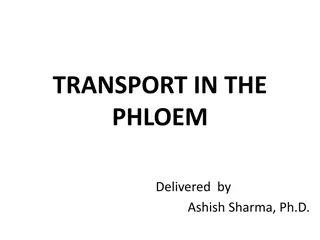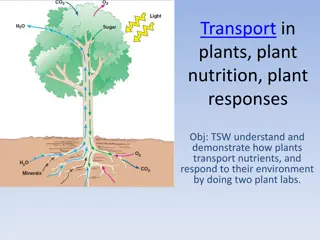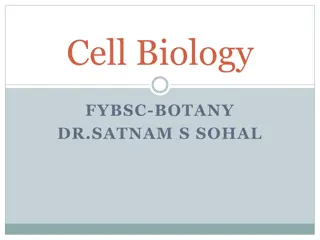Understanding Plant Transport Systems: Xylem and Phloem
Explore the intricate system of plant transport through xylem and phloem, from how roots absorb water to the pressure-flow hypothesis in sugar transport. Learn about the evolution, structure, and function of vascular tissues and the critical role of transpiration. Dive into the classification of plants based on vascular tissue and the mechanisms governing long-distance transport.
Download Presentation

Please find below an Image/Link to download the presentation.
The content on the website is provided AS IS for your information and personal use only. It may not be sold, licensed, or shared on other websites without obtaining consent from the author. Download presentation by click this link. If you encounter any issues during the download, it is possible that the publisher has removed the file from their server.
E N D
Presentation Transcript
Sugar maple, Acer saccharum Plant transport: Xylem and Phloem Chapter 4 pp. 47 -54 Lecture Outline: Evolution of vascular tissue The xylem transports water and nutrients The phloem transports sugars and other organic compounds Xylem and phloem structure and function How do roots take up water and nutrients from the soil? Cohesion-tension mechanism and transpiration relate to the physical properties of water The function of stomata in transpiration Sugar transport in the phloem The pressure-flow hypothesis describes transport of sugar in plants http://maple.dnr.cornell.edu
Plant classification and vascular tissue seedless vascular plants nonvascular plants gymnosperms (cone-bearing seed plants) angiosperms (flowering seed plants)
H2O H2O and minerals
O2 CO2 H2O O2 H2O and minerals CO2
O2 CO2 Light Sugar H2O O2 H2O and minerals CO2
Long-distance transport in the phloem and xylem Phloem Xylem Vessel Tracheids 100 m Sieve-tube element (left) and companion cell: cross section Pits Vessel element Sieve-tube elements: longitudinal view Sieve plate with pores Tracheid Tracheids
Transpiration is the evaporative loss of water from the leaves of a plant. H2O H2O and minerals
But first, water and minerals must travel from the soil through the dermal and ground tissue into the vascular cylinder (xylem/phloem) of a root eudicot root cross section
Cross section of a eudicot root Epidermis Key to labels Cortex Dermal Ground Vascular Endodermis Vascular cylinder Pericycle Xylem 100 m Phloem
Casparian strip Transport of water and mineral nutrients from root hairs to the xylem Endodermal cell Pathway along apoplast Pathway through symplast Casparian strip Plasma membrane Apoplastic route Xylem Symplastic route Root hair Epidermis Endodermis Vascular cylinder Cortex
Transpiration is the movement of water against gravity, from the soil to the leaves, without using any energy HOW do plants do this? http://photo.accuweather.com
Transpiration is the movement of water against gravity, from the soil to the leaves, without using any energy HOW do plants do this? Transpiration depends on: 1. the evaporation of H2O from the leaves pulls water upwards from the roots (tension) 2. the physical properties of water (cohesion) http://photo.accuweather.com
Xylem sap The ascent of xylem sap (water and minerals) Mesophyll cells Stoma Stoma Water molecule Atmosphere Transpiration Adhesion by hydrogen bondingCell Xylem cells wall Water potential gradient Cohesion by hydrogen bonding Cohesion and adhesion in the xylem Water molecule Root hair Soil particle Water uptake from soil Water
Xylem sap The ascent of xylem sap (water and minerals) Mesophyll cells Stoma Stoma Water molecule Atmosphere Transpiration Adhesion by hydrogen bonding Xylem cells Cell wall Water potential gradient Cohesion by hydrogen bonding Cohesion and adhesion in the xylem Water molecule Root hair Soil particle Water Water uptake from soil
The ascent of xylem sap depends on hydrogen bonds between water molecules The oxygen (O) is partially The hydrogen (H) is partially + H H2O = water O + H + +
Xylem sap The ascent of xylem sap (water and minerals) Mesophyll cells Stoma Stoma Water molecule Atmosphere Transpiration Adhesion by hydrogen bonding Xylem cells Cell wall Water potential gradient Cohesion by hydrogen bonding Cohesion and adhesion in the xylem Water molecule Root hair Soil particle Water Water uptake from soil
Xylem sap The ascent of xylem sap (water and minerals) Stomata function in transpiration Water molecule Atmosphere Transpiration Adhesion by hydrogen bondingCell Xylem cells wall Water potential gradient Cohesion by hydrogen bonding Cohesion and adhesion in the xylem Water molecule Root hair Soil particle Water Water uptake from soil
Osmosis of water causes stomata (leaf pores) to open and close Guard cells turgid Guard cells flaccid H2O H2O H2O H2O H2O K+ + H2O H2O H2O H2O H2O Water flows out of the cells, stoma closes Water flows into the cells, stoma opens
O2 CO2 Light Sugar H2O O2 H2O and minerals CO2
O2 CO2 Light Sugar H2O The Pressure-flow hypothesis describes how sugars are transported from sources to sinks via the phloem (this does require energy!) O2 H2O and minerals CO2
Source to sink Daucus carota leaves are sources in the summer time, and flowers/fruits and developing organs are sinks Daucus carota roots are sources in the springtime, and shoot is the sink
Starch - how plants store sugar Chloroplast Starch starch molecules are simply glucose molecules linked together (similar to cellulose)
Structure of the phloem Sieve-tube element Sieve plate 10 m Nucleus of companion cells Sieve-tube elements: longitudinal view Sieve plate with pores (SEM)
Pressure-flow hypothesis Source cell (leaf) Vessel (xylem) Sieve tube (phloem) 1 Load sugar into the phloem at the source (requires ENERGY!) H2O Sugar 1 H2O 2 Water from the xylem flows into the phloem (OSMOSIS) 2 Bulk flow Bulk flow 3 Unload sugar at the sink Sink cell (storage root) Water from the phloem flows back into the xylem (OSMOSIS) water is recycled, creating a constant circuit! 4 3 Sugar H2O Fig. 36-20
Lecture Review, Chap 4 Do any plants lack vascular tissue? If so, give an example of a kind of plant that lacks this particular tissue type. Relate structure to function in sieve-tube cells, vessel cells, and tracheid cells. How are water and mineral nutrients from the soil transferred into the vascular cylinder of a root? Define transpiration. Describe the cohesion-tension mechanism and relate it to the function of the stomata and the properties of water. Why do water molecules stick together? How does this relate to why plants can move water against the force of gravity without using any energy? Trace the path of sugar in the phloem from source to sink. What is the name of the hypothesis to describe this flow?

























